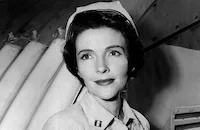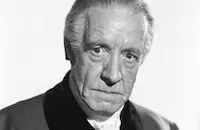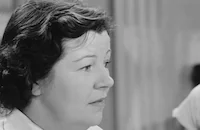Talk About a Stranger

Brief Synopsis
Cast & Crew
David Bradley
George Murphy
Nancy Reagan
Billy Gray
Lewis Stone
Kurt Kaszner
Film Details
Technical Specs

Synopsis
On Halloween night, Robert "Bud" Fontaine, Jr. and his friends break a window at an abandoned house, then run in fright after a stern-looking man glares at them from another window. Bud rushes home to tell his father Bob, an orange farmer, what has happened. The kind-hearted Bob tries to calm Bud down, assuring him that the long-absent owner, Dr. Paul Mahler, has returned. Bob apologizes to the man, who gruffly introduces himself as Matlock and says he bought the house from Mahler, whom Bob has never met. One day, Bud, who is saving money from his paper route for a dog, is followed home by a friendly stray. Bud immediately loves the dog, whom he calls "Boy," and takes him home. His mother Marge, who is having a difficult pregnancy, lets him keep the dog, and Bud is completely happy. Some time later, when Bud takes Boy with him to sell a newspaper subscription to Matlock, the dog charges into the house and breaks a vase. Matlock angrily orders them to leave, further alienating Bud. One day, Marge tells Bud that he has been invited to the birthday party of Camille Wardlaw, the granddaughter of the newspaper publisher. Bud leaves Boy at home and reluctantly walks into town to buy a gift, but instead buys a license for Boy when Camille taunts that Boy will be taken to the pound without it. When Bud gets home, he finds that Boy has disappeared. Bud searches for his dog and is shattered when he finds Boy dead, apparently poisoned, on the road in front of Matlock's house. When the disconsolate Bud tells his father, Bob confronts Matlock, who says he knows nothing and slams the door. Although Bob warns Bud that there is no proof Matlock poisoned Boy, Bud is convinced and goes to Wardlaw to see if he will put an item in the paper about it. When Wardlaw explains that he needs proof, Bud angrily runs off and starts to destroy the spout on the oil tank on Matlock's property. Wardlaw stops him and suggests that he find proof of his accusations by investigating. Malicious town gossip about the reclusive Matlock fuel Bud's obsession, and after learning that Matlock had recently bought both hamburger meat and rat poison, he sneaks into Matlock's garage. Bud finds the opened box of rat poison and also notices that his car's registration lists the owner as Mahler. Bud rushes to Wardlaw with the registration, and Wardlaw tries to contact Mahler at the registration's San Sala address, but finds that the number has been disconnected. Although Wardlaw tells Bud to return the car registration, he himself has become concerned and decides to investigate, not knowing that Bud is hitchhiking to San Sala. When Bud arrives at San Sala, he finds that the address listed on the registration is for a large, now-abandoned beach house. A boy playing nearby tells him the house is haunted and helps Bud to sneak inside. There the boy frightens Bud by saying that the man who owned the house disappeared several months before and was probably murdered. Bud then hitches a motorcycle ride home with a friendly sailor, and when he arrives, Bob angrily orders Bud to his room. Later, Bob tries to talk with Bud, who will not reveal what has happened but insists that he must see Wardlaw. Bud then sneaks out to return the car registration but is caught by Matlock, who yells at him to leave him alone. Now hysterical with anger and fear, Bud runs toward the oil tank and destroys the spout, causing gallons of oil to spill out. A few minutes later, an annoyed Bob finds Bud on the road, and tells him that they must keep the orchard smudge pots burning as the January frost is threatening the orchard. It is the coldest night of the year and heating oil is running out in the valley. While many of the local farmers wait at the Fontaine house, hoping that an expected fuel truck will arrive, Marge suggests that they ask Matlock for oil. As the men drive off, Bud tries to stop them, but no one hears him. He then rushes to the tank and, seeing the faces of the men, including Bob and Matlock, hysterically screams that he did it because he hates Matlock. Shocked by Bud's rage, Matlock runs after the fleeing boy and saves him when he falls into a stream and almost drowns. Matlock carries Bud to his house and makes him warm soup, then gently tells him that he had nothing to do with Boy's death. Bud softens after Matlock drinks some of the soup to prove that it is not poisoned, and lets Matlock walk him home. On the road, they see the tanker truck arriving just in time to save the crops. At the Fontaine home, Wardlaw greets Matlock as "Dr. Mahler," then, with Dr. Dorothy Langley, Mahler's wife, explains that their gravely ill son needed an operation several months ago and Mahler was the only one who might have saved him. When their son died during surgery, Mahler blamed himself and ran away. Mahler then tells Bud that he reminded him of his son. The next day, in Wardlaw's office, Wetzell, a local farmer, sadly admits that he was responsible for Boy's death, an accident caused by leaving out poisoned meat to kill a coyote. Bud forgives Wetzell and rides home on his bike, followed by Camille. Nearing the farm, they encounter Mahler and his wife, who are leaving for San Sala. Mahler thanks Bud and gives him a gift of a new puppy. Bud happily thanks the Mahlers and rides home.

Director
David Bradley
Cast

George Murphy

Nancy Reagan

Billy Gray

Lewis Stone
Kurt Kaszner
Anna Glomb
Katharine Warren
Teddy Infuhr
Stanley Andrews
Maude Wallace
Cosmo Sardo
Jon Gardner

Donald Gordon
Warren Farlow
Wayne Farlow
Gary Stewart

Margaret Bert
Tudor Owen
Harry Lauter
Dan Riss
Charles La Torre

Kathleen Freeman
Burt Mustin
Ralph Moody
Jack Williams
Jack Moore
William Tannen
Mitchell Lewis
Leslie K. O'pace
Harry Hines
Edward Cassidy
Virginia Farmer
Crew
John Alton
David Buttolph
Sol Baer Fielding
Margaret Fitts
Cedric Gibbons
A. Arnold Gillespie
Bert Glazer
Richard Goldstone
Eddie Imazu
Newell P. Kimlan
Arthur Krams
Frank Mckenzie
Warren Newcombe
Dore Schary
Douglas Shearer
Al Shenberg
Edwin B. Willis

Film Details
Technical Specs

Articles
Talk About a Stranger
By Frank Miller

Talk About a Stranger
Quotes
Trivia
Notes
The working titles of the film were The Enemy and Stranger in the House. According to various news items, portions of the film were shot on location in Redlands, CA. According to one pre-production news items, some location shooting was also to take place in the "citrus districts" of the San Fernando Valley in Southern California. Another news item added Napoleon Whiting to the cast, but he was not in the film. The same news item included Frank Ramsden in the cast, but his appearance in the released film has not been verified. Talk About a Stranger was the first theatrical film directed by David Bradley. His first film was Peer Gynt (1941), a highly regarded student film made while Bradley and the film's star, Charlton Heston, were students at Northwestern University (see AFI Catalog of Feature Films, 1941-50).















